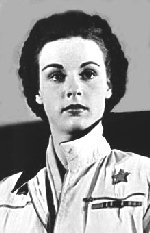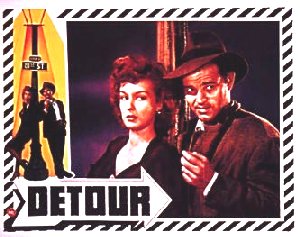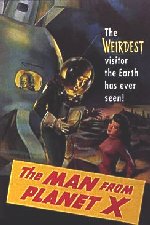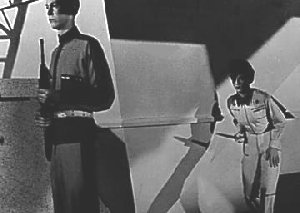Arianné Ulmer Cipes:
'The Daughter Of Director Ulmer'
A visitor to MGM brings with her a mission to preserve and promote the films of one of Hollywood's most
interesting directors.

On February 18, 1998 Arianné Ulmer Cipes, daughter of the legendary Hollywood director Edgar G. Ulmer, paid
a visit to the MGM stills department. She was looking for photos from her father's The Amazing Transparent Man
and Beyond the Time Barrier, both from 1960. Savant had the privilege of watching her look through the aged,
cloth-bound keyset books for those titles as the guest of stills archivist Gary Teetzel. Together we listened to
her firsthand accounts of her famous father, for whom she also worked as an actress, and her present worldwide
quest to reassemble the film record of what has to be one of the most unusual cinema careers on record.
A very young Edgar Ulmer began as a set builder and art director for F.W. Murnau (talk about starting at the top)
and seems to have quickly penetrated the creative heart of the top European cinema of the 1920's. According to
accounts, he worked on film designs for Swede Maurice Stiller, French comedian-director Max Linder, and Germans
Murnau, Ernst Lubitsch, William Dieterle and Fritz Lang, contributing to
Die Niebelungen (1924), Metropolis (1926), Spione (1928) and "M" (1931).
Ulmer's first directing job was on a film he produced and co-directed with Robert Siodmak in Berlin called Menschen am sonntag (1929), which also involved the participation of future greats Billy Wilder and Fred Zinnemann. Following Murnau to Fox pictures in California, Ulmer designed the huge, staggeringly beautiful exterior sets for Sunrise (1927), requiring the studio to purchase a tremendous lot (now most of Century City) to accomodate them.
After directing what is regarded as the finest Boris Karloff/Bela Lugosi collaboration, The Black Cat (1934), Ulmer worked almost completely outside the normal Hollywood system, a creative dynamo who not only dashed out coherent little four-day classics for underdog studios like PRC, but who made ethnic Yiddish and Ukranian folktale movies in New Jersey (!!).

Daughter Arianné's mission to assemble and restore screenable quality copies of Ulmer's prodigous stack
of titles is no small task. The films of most directors can be rounded up with a few phone calls, and difficult
titles are normally the exception. With Ulmer almost every picture is an exception. One has a reasonable expectation
that a major studio can locate copies of most of their films, but Ulmer's work was done either for defunct studios
(PRC, whose output was sold to TV and seemingly cast to the winds) or for renegade one or two-shot independent
producers. Ratty public domain copies have been openly available for many of Ulmer's greatest films; even in Los
Angeles, where wonderful revival prints surface all the time, I have never seen one of the rumored decent prints of
Detour (1945).

To this end, Ms. Cipes has been corresponding with individuals all over the states, Europe and even Israel,
locating and preserving the Ulmer legacy wherever it can be found. As this can be expensive, she has begun
the Edgar G. Ulmer Preservation Corporation, a nonprofit Public Benefit Corporation, committed to the
"preservation and propagation of the work of independent, pioneering filmmakers." She has begun to see some
results from her labors, and has plans for retrospective screenings of some of the best of the newly collected
Ulmer films, in New York in the Fall and perhaps here in Los Angeles in the Spring of 1999. The addresses
and phone # for the Corporation are at the bottom of this column.
If you know studio history, you might think that MGM would be brimming with Ulmer titles. PRC, where he shot
at least six films in the 1940s, merged with Eagle-Lion, which itself later merged with United Artists. Arianné
would be particularly happy to locate good elements for The Strange Woman and St. Benny the Dip. But
the only Ulmer epic remaining in the UA corral is the nifty independent production
The Man from Planet X (1951). As curator, UA has
maintained beautifully pristine elements for that moody gem. It's a real treat to see, especially after years of
watching public domain cassettes of incredibly poor quality. Wouldn't you know it, Ulmer's first foray into
science fiction filmmaking is also the first film ever about an invader from outer space - it beat
The Thing from Another World into the theaters by
a few weeks.

At this time it is difficult to speculate on whether The Amazing Transparent Man and Beyond the Time
Barrier will emerge from the Orion/A.I.P. library acquisition as video releases. But Arianné got her
first look at the complete stills set of Time Barrier, which brought back a few memories of her acting
turn as that film's "beautiful, yet villainous Markova." Still a very attractive lady, Arianné's immediate
enthusiasm for her quest is infectious. Were I hiding an Ulmer negative in my basement, I'd be digging it up
for her right now.
I think Arianné's efforts will eventually succeed, due to her persistence and charm and also to the
charm of her famous father, whose films seem to have found a permanent place in the hearts of film lovers.
"Film Preservation" gets a lot of talk these days, but in most every case it is the dedication of individuals
like Ms. Cipes that really makes it happen.
Update 11/12/99: From Arianné, on the progress of her "quest": "As you probably
know we did have both the Film Forum retro in
November 98 and the American Cinematheque in August of 99. We have also
amassed a collection of 33 films in 16mm and 3 films in 35mm in the Ulmer
Collection at the AMPAS archive to date. Please note that we have our first
DVD on the market this last month. It can be checked out at
alldayentertainment.com. It features The Strange Woman
and Moon Over Harlem. We are delighted with the
progress and must give credit where credit is due. Without the support of
people like yourself my efforts would never reach the general public. Thank
you again for helping me in my quest."
Savant Recommended Reading:
"Edgar G. Ulmer; the Primacy of the Visual", Myron Meisel, KINGS OF THE B'S, Todd McCarthy & Charles Flynn. E.P. Dutton, 1975.
"Edgar G. Ulmer" interview , WHO THE DEVIL MADE IT?, Peter Bogdanovich, Knopf, 1997 p. 560-604.
"Edgar G. Ulmer: Visions from the Second Kingdom", Bret Wood, and "Her Father's Keeper: Arianné Ulmer Cipes Interviewed", Tom Weaver, Video Watchdog No. 41, 1997.
Contact:
The Edgar G. Ulmer Preservation Corporation , a nonprofit Public Benefit Corporation
Donations to: Edgar G. Ulmer Preservation Corporation, 3651 Stone Canyon Avenue, Sherman Oaks, CA 91403-4530
Phone/Fax (818) 789-2477
E-mail: [email protected]
Savant reviews of Edgar G. Ulmer titles:
Savant Review: Detour
Savant Review: The Daughter of Dr. Jekyll
Savant Essay: The Man from Planet X
Go BACK to the Savant Index of Articles.
Text © Copyright 1998 Glenn Erickson
DVD Savant Text © Copyright 2007 Glenn Erickson
|










